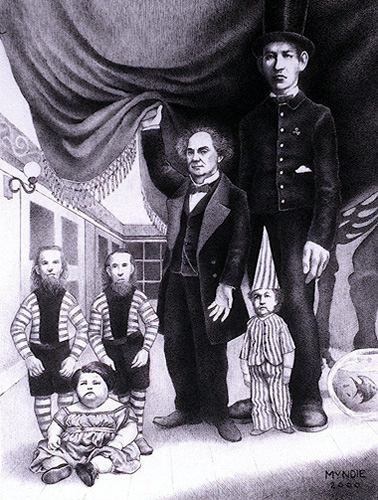|
|
The Showman and His Museum

Pen and ink, 9 x 6.75 inches, 2000
Phineas Taylor Barnum was undoubtedly the greatest showman who ever
lived. In his constant search for the exciting and innovative, Barnum revolutionized
modern popular entertainment. Through his American Museum in New York, P. T. Barnum introduced
many of the world's most famous performers as well as the modes of presentation for subsequent generations.
The name Barnum was synonymous with fun and fraud, both of which his audience found equally
delightful.
In the operation of his museum, Barnum expanded upon the sort of institution
founded by men like Charles Willson Peale, upon whose self-portrait in
the collection of the Pennsylvania Academy of the Fine Arts this drawing
is based. Peale's museum contained natural history specimens and various
curiosities, which the public could view for a small admission. Initially,
the museum was intended as a means to educate the public, but Peale soon
realized that if he wished to remain solvent, he had to entertain as well.
Despite misgivings, Peale added musicians and other performers to attract a larger audience.
Barnum took this model a step further with his uncanny knack for publicity,
humbug, and by understanding the sort of attractions people would flock to see.
In this portrait, Barnum is surrounded by some of the attractions
that helped make him famous. To his left sits a fish bowl as a symbol of
a Barnum innovation — America's first public aquaria (including live whales!); one of a seemingly
endless line of Irish giants; and the famous Commodore Nutt, rival to
General Tom
Thumb. To Barnum's right is one of his favorite features, an
enormously fat child; and the Wild
Men of Borneo, who were actually brothers from Connecticut. Behind them
all stand — like the mammoth in Peale's painting — the mounted skeletal
remains of Barnum's most famous animal prodigy, the enormous African elephant known as Jumbo, who
served as a major circus attraction in both life and death.
|

|

|

|
All Images and Text © James G. Mundie 2003 - 2018
|



